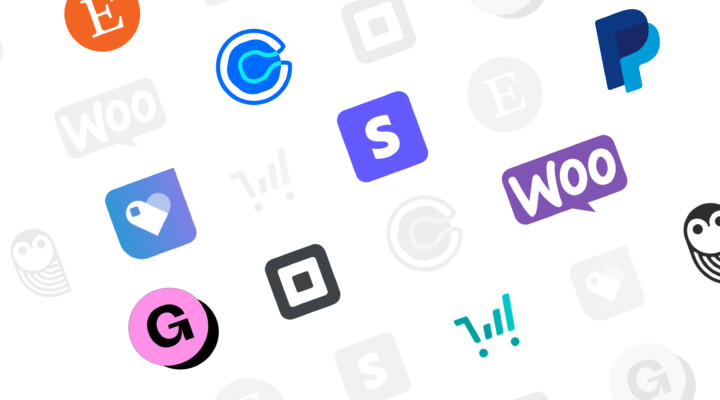If you’re looking to compare social networks specifically to promote your affiliate campaign, make sure to check our free guide on how to use social media and messengers for affiliate marketing. There, you’ll be able to learn how to choose the right network, create a powerful campaign, increase organic reach and leverage paid traffic.
Why Invest in Social Media Marketing
As social media is used by over 3.6 billion people worldwide, it is one of the most efficient tools for brands to grow outreach and achieve their marketing goals. Here are 10 more reasons why you should consider using social media platforms for business growth:
- Build brand recognition. Social networks will increase your outreach faster and easier than many other channels. You can get people looking at your brand even if they don’t know about it yet.
- Research audiences. By analyzing your following, you’ll gather a lot of valuable data that will show how to make your campaign more efficient.
- Provide high-quality customer service. Networks allow businesses to communicate with clients and gather feedback immediately. This, in turn, helps create meaningful relationships with your audience.
- Increase client loyalty. Research reveals that over half of customers who follow a brand on social networks are more likely to choose it over competitors.
- Grow website traffic. If you leave a link to your site on social media, it might considerably increase your site traffic.
- Build links. Strong content is likely to generate shares and, as a result, get backlinks. They, in turn, will make Google rank your page higher.
- Establish authority. Through sharing content, you can build credibility, become a valuable source of information and build loyalty with users. The narrower your topic, the easier it will be to establish authority within that niche.
- Drive conversions. Social media is a great way to engage your followers and drive sales. For example, you can run contests and giveaways to spark your audience’s interest. Another way is by leveraging advertisement on social networks, which is usually less jarring.
- Leverage social proof. A growing following is indicative of a brand’s trust with its audience, as well as its legitimacy and authority. Content that is actively gaining shares looks more authoritative and relevant and serves as great social proof.
- Share updates. Keep your audience updated about the latest deals, upcoming events, and all kinds of news from your business.
What’s more, social media marketing can be free: just create a page on a network and start sharing content. Growing your following organically and engaging doesn’t cost a thing either. But if you have a budget to spare, social advertising will help boost your campaign much faster.
Choosing the Right Social Media Platform for Your Business
With so many networks available today, establishing your presence across all of them may seem overwhelming. Below, we’ve compared the most popular social media platforms for businesses to help you understand their target audiences, popular types of content, and other distinctive features.
Campaign Goals
When choosing the right social media platform for your business, check whether it will allow you to reach your campaign objectives most efficiently.
Facebook is a leading social network with over 2.7 billion users. Due to this enormous reach, Facebook offers great conditions to build relationships with your audience and attract new customers. Many brands register on the platform to provide their followers with space to interact and ask questions.
Facebook also offers advanced advertising via targeting by age, gender, job, hobbies, behaviors, and more. Powerful analytic tools will help you stay on top of your advertising campaigns, but you’ll need some marketing budget to start off.
Instagram is perfect for generating leads and building relationships. By consistently sharing visual content, you’ll grow brand recognition and build a following. As Instagram is owned by Facebook, it provides marketers with access to an extensive database of users and advertising possibilities.
YouTube allows marketers to create brand awareness and educate their followers. Video tutorials and how-to guides can help drive conversions and allow you to connect with your followers as well as demonstrate the benefits of your products and back up written content. YouTube is owned by Google, has access to its advertising platform, and allows for increasing outreach through search optimization.
TikTok is a relatively new app, but is already considered one of the best social networks for business. It isn’t as saturated as other platforms, thus offering a lot of room for new businesses. However, TikTok is constantly changing its policy regarding affiliate links and its advertising options are rather limited. TikTok is perfect for younger audiences and for creating brand recognition.
LinkedIn is great for business development and networking. It provides perfect conditions for recruiting talent, finding business partners as well as B2B customers. Make sure to create a LinkedIn business page to expand your professional network, share business-related content, and establish niche authority. The platform also has advertising opportunities to promote content, send ads to inboxes, or place them in the sidebar.
Twitter is often used for building public relations. Brands leverage the network to share news and articles, so make sure to build a presence on Twitter if you want to establish authority as a “thought leader” within your niche. Twitter is also the right place to connect with your clients, as advertisers report that over 80% of their customer service requests happen here. Finally, the hashtag feature helps find potential customers who are looking for a specific product.
Pinterest has a lot of potential for driving traffic and lead generation, as 90% of users come to the platform to find inspiration for future purchases. Marketers can easily increase their organic reach with relevant keywords at no extra cost. Ads here are less advanced and expensive than on Facebook and Twitter.
Snapchat can be used for sharing real-time updates or behind-the-scenes pictures, creating an image for your brand, or reaching new customers. “Self-destructing” snaps prompt users to act fast, so they’re great for boosting engagement. Marketers can also leverage Snapchat’s powerful ads, which garner 1.5 times more visual attention than Instagram and twice that of Facebook.
Whatever your goals are, social media management tools will allow you to automate work and run the promotion more smoothly.
Audience
Social media is all about getting marketers in touch with their audiences. Choosing the right social media platform for your business is impossible without getting to know your customers first. Below, there is an overview of the demographics of different target audiences on different networks.
| Social network | Number of active users | Gender | Largest age groups |
| 2.7 billion | 56.4% male 43.6% female | 25-29- and 30–49-year-olds | |
| 1 billion | 49.1% male 50.9% female | 18-24- and 25–29-year-olds | |
| YouTube | 2 billion | 56% male 44% female | 25–30-year-olds |
| TikTok | 1 billion | 53% male 47% female | 18-24- and 13–17-year-olds |
| 740 million | 57% male 43% female | 25–34-year-olds | |
| 330 million | 66% male 34% female | 18–24-year-olds | |
| 322 million | 71% female 29% male | 18-24- and 30–49-year-olds | |
| Snapchat | 249 million | 59% female 39% male | 18–24-year-olds |
Type of Content
For each social platform, there are specific types of content that perform better than others. To create a powerful social media strategy, you need to consider which content you share most often and what will work best for your brand.
On Facebook, various content types are appropriate, but videos, photos, contests, and articles perform remarkably well. The platform’s algorithm prioritizes posts that ignite meaningful conversations and connect people. Videos are powerful in this regard. It’s also the right place to share webinars and announce events.
Instagram is a visual platform that allows users to post photos and videos. Instagram Stories offer great opportunities to announce product launches and draw attention to limited releases. You can also do livestreams and share long videos on IGTV.
YouTube is the go-to network for sharing videos. How-to guides and reviews are the most popular forms of materials on the platform.
The content that works exceptionally well on TikTok is highly diverse: memes, educational content, recipes, life hacks, behind the scenes, decor ideas, beauty and fashion tutorials, social media challenges, etc.
LinkedIn is great for sharing editorial content that will help build authority in your field and generate leads. It’s the best social network to establish a presence for B2B companies.
Twitter users can post short-form content up to 280 characters in one tweet (and even less for oriental languages). The platform favors real-time information, so it’s often used to share things that are happening at the moment. Text tweets perform better than images or videos, while how-to guides, listicles, and quotations get the most traction on the platform.
Pinterest is a visual search tool best for sharing all kinds of visuals, such as photos, infographics, etc. You can create a blog board and make beautiful pins for all of your posts or share posts on group boards to increase your outreach.
Snapchat users share photos and short videos (up to 60 seconds) with their friends. The app isn’t limited to selfies, as users can add filters, masks, and emojis. Snaps are automatically deleted after they’ve been viewed by all recipients, so they can’t be saved or shared. This short Stories format can be great for sharing brand updates and news that is relevant within a short time.
Affiliate Marketing
Social media platforms present great opportunities to earn an income, but when it comes to affiliate marketing, not all networks are equally friendly. Below is a brief overview of the most popular networks. You can also read our tips on how to use social media and messengers for affiliate marketing in our guide.
Facebook allows marketers to share links right in the posts so they don’t need to have a website to start earning. The platform provides advanced analytical tools to control and adjust campaigns along the way. However, Facebook has restrictions on promoted content, so you need to consider the rules when running a promotion. Learn how to leverage affiliate marketing and other monetization strategies on Facebook in our guide.
Instagram is one of the best social networks for business promotion, but the downside is that it doesn’t allow links to be placed within posts. However, marketers can still embed links in their profile bio, swipe-up in Stories, direct messages, promoted posts, through link services like Linkngo, etc. Advertising opportunities are quite advanced, while integration with Facebook allows for cross-promotion. Learn more about Instagram monetization strategies in this guide.
YouTube is the world’s second largest search engine and allows plenty of monetization opportunities, including affiliate marketing. Webmasters create video content and share affiliate links in the videos or in the description section to send traffic to their sites and landing pages. Learn how to make money on YouTube in this guide.
TikTok is quite a challenging social platform for business in the affiliate marketing niche, as it forbids adding clickable links to videos and some bios. However, marketers can use organic content and paid ads to attract an audience and build brand awareness. But as TikTok is still gathering pace, the competition is low, so it might be one of the best social media platforms for small businesses to jump into.
LinkedIn’s blogging features allow you to easily share content and include links. For example, you can share a case study or a how-to guide for your product and add an affiliate link or a link to your blog.
To perform affiliate marketing on Twitter, you first need to amass a strong following, create quality content to get the community engaged, and only then start promoting affiliate links. To increase outreach, you can leverage hashtags or direct advertising.
Pinterest is one of the best platforms for affiliate marketers. 90% of users find inspiration for their purchases here, so the platform presents great opportunities for promotion. You can add affiliate links directly to pins or send customers to landing pages with affiliate offers. The built-in shopping feature allows marketers to easily drive traffic to advertisers’ websites. Learn more about how to make money on Pinterest in our guide.
Snapchat features high user engagement, low competition, and earning potential. Marketers can gather a contact base and then generate engagement by arranging a contest, sharing discounts, announcing upcoming events, broadcasting live, etc. and send users to the website or landing page with affiliate links. Find more monetization strategies for Snapchat in our guide.
Type of Business
Facebook suits all kinds of businesses due to its huge audience outreach and broad geographical spread. Make sure to register on the platform to connect with users and build recognition for your brand.
Instagram is right for businesses with younger audiences and those who prefer to shop from their mobile devices. With its checkout feature, Instagram is great for ecommerce stores which can share product images and make sales right away. Instagram followers tend to live in urban areas, so the platform will be most beneficial for businesses in niches such as travel, health, fitness, beauty, fashion, art, food, retail, entertainment, etc.
If you are in the service industry, Youtube is your best bet, as the platform allows you to share all kinds of educational content as well as demonstrate product benefits and reviews in the most compelling way.
TikTok is the most popular platform among young audiences aged 16-24, which creates certain restrictions in terms of outreach for ecommerce businesses. Research reveals that the most popular content categories on TikTok are entertainment, dancing, pranks, fitness and sports, home renovation and DIY, among others. But almost any brand can use the platform to build rapport with their audience.
LinkedIn is the right fit for B2B businesses. If you work in the corporate, business, or job sphere, look no further.
Twitter is particularly popular in niches such as news, entertainment, sports, and politics, so it has a pretty diverse audience. However, software and tech businesses also see the most success on this platform.
Pinterest is better suited for travel, home decor, food, lifestyle, photography, clothing, and all kinds of creative brands. Ecommerce businesses can also thrive on Pinterest, as an overwhelming majority of users come there to inspire purchases.
Snapchat is the social network to be on if your brand mainly targets younger audiences. Snapchat Stories are mostly used by brands in the luxury, food and beverage, fashion and lifestyle industries.
How to Use Different Social Media Platforms for Business
Social media marketing is important for any brand looking to increase online exposure, gain new leads, grow traffic, and drive conversions. The key to choosing the right social media platform for your business is all about identifying your objectives and target audience and aligning those things with what each network has to offer. Combining various channels will give you more reach and allow for a more diversified content strategy.




